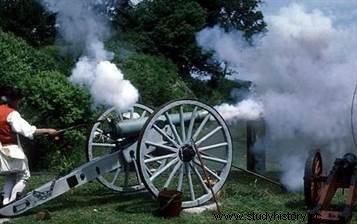 The Canon as we know it was an invention developed in Europe in 1313 by Berthold Schwarz (a German monk), three centuries after the invention of gunpowder by the Chinese. Later, a certain Bonaparte will have the audacity to exploit the cannon as a mobile support force for infantry attacks and will make it one of his key pieces in his conquest of Europe.
The Canon as we know it was an invention developed in Europe in 1313 by Berthold Schwarz (a German monk), three centuries after the invention of gunpowder by the Chinese. Later, a certain Bonaparte will have the audacity to exploit the cannon as a mobile support force for infantry attacks and will make it one of his key pieces in his conquest of Europe.
The invention of the cannon
Early cannons used powder charges to fire stone or metal balls. Until the 19th century, they were smooth metal tubes loaded by the breech (14th-15th centuries), then by the mouth, pointed manually!; the recoil was absorbed by the rearward movement of the carriage. Modern guns, loaded through the breech (at the rear of the barrel), consist of a forged steel tube that is rifled, i.e. has helical grooves to give the projectile a rotary motion which improves precision and range. The carriage is equipped with recoil absorption and return to firing position mechanisms. Elevation and displacement devices allow manual or electric aiming, or sometimes fully automatic, with tracking and tracking of targets by radar.
 Ammunition includes high-explosive shells, anti-tank shells, smoke, illuminating or signal shells, shells containing chemical agents and nuclear warhead shells. Cannons can also fire projectiles bearing propaganda leaflets or providing vital medicine to isolated troops. Other ammunition is used to drop carpet anti-tank or anti-personnel mines.
Ammunition includes high-explosive shells, anti-tank shells, smoke, illuminating or signal shells, shells containing chemical agents and nuclear warhead shells. Cannons can also fire projectiles bearing propaganda leaflets or providing vital medicine to isolated troops. Other ammunition is used to drop carpet anti-tank or anti-personnel mines.
On the battlefield
In the 18th century, the French engineer Gribeauval developed a complete system of mobile and powerful artillery, produced in a standardized series (1765), which greatly contributed to the victories of the Revolution and Empire. The artillery, "queen of battles", then took a prominent place in the armies. Implemented in batteries of several guns, it was used to destroy enemy attack formations or to disrupt the opposing defense before attacking.
Until the 19th century, the barrel evolved little, despite some efforts to improve the range, accuracy and destructive effect of this weapon. The black powder limits the improvements because it clogs the mechanisms. In 1884, the French chemist Paul Vieille developed smokeless gunpowder. It is the beginning of a new era in the history of armament and warfare:the thick smoke that covered the battlefield almost disappears. Furthermore, the use of picric acid-based explosives in the loading of the shells increases their effectiveness tenfold. At the end of the 19th century, French artillerymen developed the 75 mm field gun, the first rapid-fire gun, and solved the problem of recoil during the explosion of the propellant charge thanks to a hydropneumatic brake.
During the First World War, devastating artillery fire prohibited each side from maneuvering, forcing trench warfare. The solution was the tank, first called the assault gun (1917). The Second World War saw the return to manoeuvre, using thousands of tanks and troop transport vehicles. The artillery nevertheless played a decisive role, especially on the Russian front.
To go further
-Of Guns and Men - A History of French Artillery. Lavauzelle, 2011.
- The 1001 inventions that changed the world by Jack Challoner. Flammarion, 2010.
